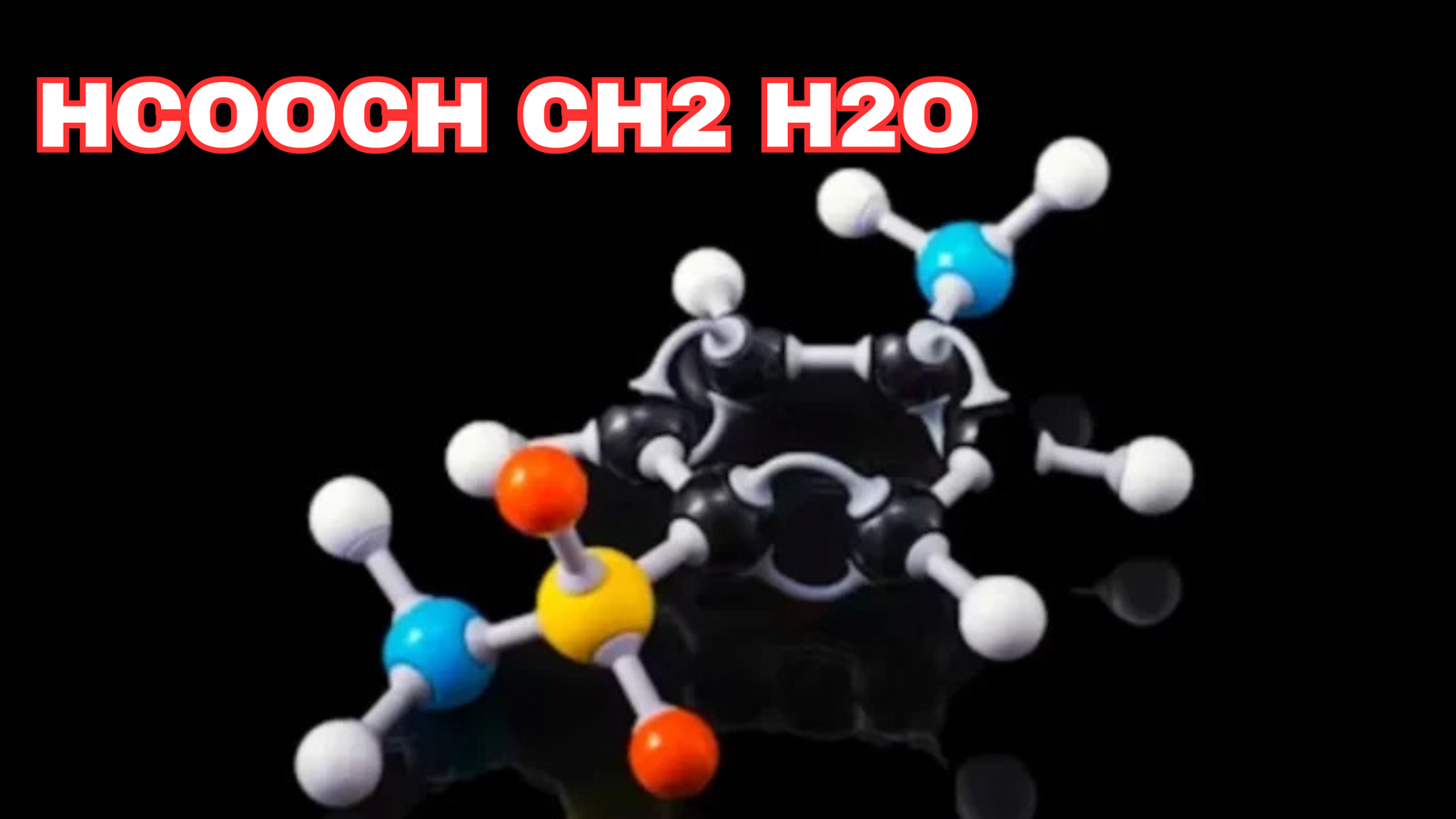HCOOCH CH2 H2O may appear as a complex chemical formula at first glance, but it represents a compound with fascinating properties and significant industrial and biochemical applications. This compound, which includes an ester group, a methylene chain, and water, is essential in processes ranging from biochemical reactions to industrial manufacturing. Exploring the intricacies of this molecule provides a deeper understanding of its structure, reactions, uses, and future potential.
In this comprehensive article, we will break down the chemical structure of HCOOCH CH2 H2O, examine its behavior in biochemical reactions, explore its industrial uses, and discuss its future in sustainable chemistry. Furthermore, we will analyze the environmental impact and its importance in the broader context of chemical science.
What Is HCOOCH CH2 H2O?
HCOOCH CH2 H2O is a compound consisting of three primary components:
- HCOO – Ester Group: This segment represents the ester functional group, where a carbonyl group (C=O) is bonded to an oxygen atom (O) linked to an alkyl group. Esters are known for their involvement in various organic reactions and play a key role in producing fragrances and solvents.
- CH2 – Methylene Group: This indicates a two-carbon chain, critical for connecting the ester group to other functional units.
- H2O – Water: The presence of water in the formula suggests the compound is involved in hydrolysis reactions, where water breaks down molecules into simpler components.
By dissecting these elements, we can better understand how the compound interacts with other chemicals and its role in chemical reactions.
The Role of Esters in Organic Chemistry
Esters, like the HCOO group in HCOOCH CH2 H2O, are organic compounds formed through the reaction between an acid and an alcohol. This reaction, called esterification, is fundamental in organic chemistry.
Key Roles of Esters:
- Aromas and Flavors: Esters are responsible for the pleasant scents of fruits and flowers, making them valuable in the fragrance and flavoring industries.
- Solvents: Many esters act as solvents in the manufacturing of paints, coatings, and adhesives.
- Biological Functions: In living organisms, esters are found in fats and oils, playing essential roles in energy storage and metabolic processes.
The ester in HCOOCH CH2 H2O is particularly interesting because it undergoes hydrolysis in the presence of water, breaking down into simpler molecules like methanol and formic acid.
Hydrolysis of HCOOCH CH2 H2O: A Critical Reaction
Hydrolysis is a chemical process where water is used to split molecules. For HCOOCH CH2 H2O, hydrolysis results in the formation of formic acid (HCOOH) and methanol (CH3OH).
Chemical Equation:
HCOOCH3+H2O→HCOOH+CH3OH\text{HCOOCH}_3 + \text{H}_2\text{O} \rightarrow \text{HCOOH} + \text{CH}_3\text{OH}HCOOCH3+H2O→HCOOH+CH3OH
This reaction can occur under both acidic and basic conditions. In acidic environments, a proton catalyzes the breakdown, while in basic conditions, a hydroxide ion facilitates the process.
Steps in the Hydrolysis Mechanism:
- Protonation of the Ester: Acidic conditions protonate the carbonyl oxygen, increasing the electrophilicity of the carbon atom.
- Nucleophilic Attack: Water, acting as a nucleophile, attacks the carbonyl carbon, forming a tetrahedral intermediate.
- Bond Cleavage: The ester bond breaks, producing methanol and a protonated form of formic acid.
- Deprotonation: Formic acid is deprotonated to yield the final products.
This reaction is widely utilized in industries to produce methanol and formic acid on a large scale.
Industrial Applications of HCOOCH CH2 H2O
The industrial relevance of HCOOCH CH2 H2O stems from its ability to break down into useful products through hydrolysis.
- Production of Formic Acid: Used in textile dyeing, leather processing, and as an antibacterial agent in agriculture.
- Methanol Manufacturing: A key raw material for producing formaldehyde and other organic compounds.
- Solvent Usage: Its ester component makes it an effective solvent in paints, adhesives, and cleaning agents.
- Renewable Energy Storage: Research indicates that esters like HCOOCH CH2 H2O could store excess renewable energy by converting carbon dioxide into storable chemical energy.
Environmental Impact of HCOOCH CH2 H2O
While esters are generally considered to have a lower environmental footprint than many synthetic chemicals, their production and disposal must be managed carefully.
Positive Aspects:
- Biodegradability: Many esters break down naturally, reducing long-term environmental harm.
- Green Chemistry Potential: Can be synthesized from renewable resources like carbon dioxide.
Challenges:
- Wastewater Contamination: Improper disposal of ester-based cleaning agents can pollute water systems.
- Energy-Intensive Processes: Industrial hydrolysis requires significant energy, contributing to carbon emissions if sourced from fossil fuels.
Sustainable production practices and innovative recycling methods are critical to mitigating these issues.
Future Prospects of HCOOCH CH2 H2O in Sustainable Chemistry
The future of HCOOCH CH2 H2O lies in its potential applications in green chemistry and renewable energy storage.
- Carbon Capture and Utilization: Researchers are exploring methods to synthesize this compound from captured carbon dioxide, offering a pathway to reduce atmospheric carbon levels.
- Biodegradable Materials: Esters are key in developing eco-friendly plastics and materials that break down more easily than traditional polymers.
- Energy Storage Solutions: The ability of esters to store and release chemical energy positions them as candidates for renewable energy storage systems.
Conclusion
HCOOCH CH2 H2O is a compelling chemical compound with diverse applications in both natural and industrial processes. Its ability to undergo hydrolysis makes it essential in biochemical reactions and the production of valuable chemicals like methanol and formic acid. With ongoing research into sustainable synthesis and green chemistry applications, this compound could play a pivotal role in addressing global environmental challenges.
Understanding its structure, properties, and uses provides insights not only into organic chemistry but also into future innovations that balance industrial needs with ecological responsibility.
Frequently Asked Questions
What is HCOOCH CH2 H2O?
It is a chemical compound consisting of an ester group (HCOO), a methylene group (CH2), and water (H2O), significant in biochemical and industrial processes.
What happens when HCOOCH CH2 H2O undergoes hydrolysis?
It breaks down into formic acid (HCOOH) and methanol (CH3OH) under acidic or basic conditions.
What are the industrial applications of HCOOCH CH2 H2O?
It is used to produce solvents, methanol, and formic acid, and has potential in renewable energy storage.
Is HCOOCH CH2 H2O environmentally friendly?
It is biodegradable but requires careful handling to avoid water pollution and energy consumption concerns.
How does HCOOCH CH2 H2O relate to green chemistry?
It can be synthesized from carbon dioxide and used in creating eco-friendly materials and energy storage solutions.
Why is HCOOCH CH2 H2O important in organic chemistry?
Its ester group participates in key organic reactions like hydrolysis and esterification, fundamental to various applications.





